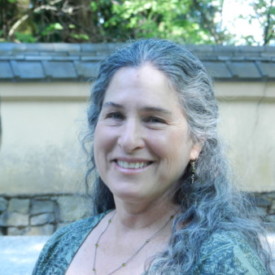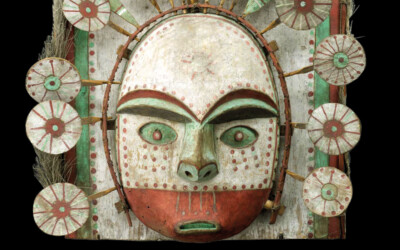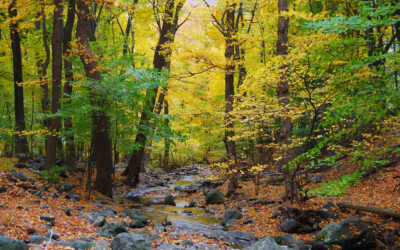“To journey without being changed is to be a nomad. To change without journeying is to be a chameleon. To journey and to be transformed by the journeying is to be a pilgrim.”
-Mark Nepo, The Exquisite Risk¹
As a shamanic initiatory rite of passage, pilgrimage has become a powerful vehicle for awareness and transformation in my own shamanic development. Consequently, I am excited to share diverse ways that shamanic awareness and practices can deepen the initiatory experience of pilgrimage, as well as how pilgrimage may enliven shamanic practice. I have been exceptionally fortunate to accompany shamanic teachers and colleagues on several pilgrimages, both as part of my formal initiation into their shamanic traditions and as a participant-observer, and to have undertaken numerous solo pilgrimages as well.²
My engagement with pilgrimage evolved organically since childhood. From the age of five, I investigated every spiritual path I could find, visiting local churches of various denominations and sacred sites in the West, hiking and backpacking deep into wilderness to commune with the Spirits of Nature, and years later, continuing as a cultural/transpersonal anthropologist, conducting fieldwork with shamans and healers from diverse cultures. Most of my professional fieldwork over the last forty years has involved lending my ethnographic skills as an anthropologist to help document, preserve and maintain endangered shamanic traditions for future generations. Unlike conventional cultural anthropologists, my preferred fieldwork methodology has been experiential, meaning that I have worked closely or apprenticed with shamans, entering into states of consciousness and rituals appropriate to their shamanic roles, when invited. These rituals included several shamanic initiatory pilgrimages. My Nepali shaman teachers fully embraced my dual role as participant and observer/researcher, while in contrast, of the nine Tibetan Spirit Mediums in-exile whose practices I documented, only one invited me to apprentice with her. Exclusion from experiential participation usually stemmed from my not exhibiting the particular cultural form of Spirit Illness that marks those shamans as being “chosen by the Spirits” for that role, and because in some regions, certain shamanic activities were restricted to men.
Many ancient religious pilgrimages routes, no longer restricted to believers of particular faiths, have become increasingly popularized and commodified in the contemporary era. (Many pilgrimage sites were commercial zones in ancient times as well).³ Pilgrims from all over the world now take the healing waters of Lourdes, France; walk the Camino to Santiago de Compostela in Spain, circumambulate Mt. Kailash in Tibet or Shikoku Island, Japan; visit Varanassi, Bodhgaya or the massive Kumbh Mela in India, to name only a few.4 Nowadays, the practice of pilgrimage extends beyond sacred religious journeys to holy sites and biographical shrines, to include more secular journeys, such as visits to Graceland to honor the American culture hero, Elvis;5 “Run for the Wall,” the yearly cross-country motorcycle pilgrimage to the Vietnam Memorial in Washington D.C. to honor the fallen,6 or the annual summer pilgrimage to the barren playas of Nevada, where tens of thousands gather at the Burning Man Festival to exchange knowledge and burn a towering effigy.7 That pilgrimage continues to exercise such powerful magnetism in the modern era testifies to its transformational power, reflecting an ancient and persistent archetypal calling to initiation, a longing for deeper spiritual direction and purpose in our lives, and a much-needed reconnection to “all our relations”—to the elements, land and nature, and our ancestral, social and non-human connections, if not also to archetypal forces such as Spirits, deities, gods/goddesses, and Creator/Creatrix.
The purposes for undertaking shamanic or religious pilgrimage traditionally range from fulfilling a spiritual vow, finding or deepening one’s faith, asking for a boon (healing, prosperity, fertility) for oneself or others, requesting guidance with regard to life’s challenges, rendering homage, to re-aligning with one’s spiritual purpose and passion. Like most religious traditions, many shamanic traditions incorporate pilgrimages to sacred sites as important initiatory rituals. Shamanic pilgrimage differs from religious primarily in its focus on receiving guidance from non-ordinary Helping Spirits, deities or the Spirits of Nature. In much of Asia, for example, shamanic and religious motivations overlap. In many shamanic traditions neophytes make pilgrimages to powerful sacred sites often connected to origin myths or other sacred stories–sacred mountains, caves, lakes, the ocean, waterfalls, shrines, or cemeteries–in order to accumulate and solidify healing power, vision, wisdom, and to bless or receive shamanic costumes or sacred objects for later use in healing rituals. Since initiation is a never-ending, ever-becoming process for shamans guided by their Helping Spirits, they may undertake many pilgrimages throughout their lifetimes.
This sacred quest involves a ritualized, possibly archetypal, sequence characteristic of rites of passage/initiations worldwide: First, during a separation phase typified by ritualized displacement or exodus from one’s ordinary life, social networks and obligations, initiates are stripped of their former social roles and status and assume egalitarian relations. Second, through the challenges of the journey itself, an immersion into a liminal, transitional phase or threshold state of consciousness is precipitated by planned or spontaneous ordeals, disorientation, austerities, physical and emotional pain, exertion and fatigue. While pilgrimage generally is understood as a journey of sufficient distance or difficulty as to prove a hardship, in my experience, intentional shamanic pilgrimage of whatever distance or duration typically engenders its own Spirit-given challenges. Pilgrims sometimes travel alone, but more often join with others, and through their shared challenges, experience the bonding, oneness or unity known as communitas. Following ordeals, sacrifices or challenges, sacred and secret knowledge (sacra) is often revealed to the initiate in this liminal phase. This could be outer knowledge revealed by elders, teachers, or the Spirits, or internal knowledge of one’s own spiritual path or purpose.
The initiatory pilgrimage usually concludes with a reincorporation or return phase, in which the sacred travelers, transformed by their accomplishments, perseverance in overcoming challenges, and the revelation of sacra, bring back to their home communities the gifts of their new perspectives, powers, inspirations and personal transmutations. This archetypal pattern, as first articulated by Van Gennep8 and reiterated by Victor and Edith Turner,9 has been contested more recently by scholars working in different cultural settings, who view pilgrims as sometimes engaged in complex, even divisive, “negotiation of class, personal identity, and purity of intention.”10
Viewed cross-culturally, pilgrimage is certainly a complex and dynamic process. In my own experience, recognizing which phase in this archetypal pattern I am experiencing adds meaning and perspective to my journey. When I experience physical or emotional distress, fear, confusion, discomfort, cherished plans going awry, recognition of my place in this near-universal process facilitates relaxation into a deeper appreciation of how these ordeals, central to rites of passage, lead to personal and collective spiritual gains. When endurance and resilience in the face of dismemberment eventually or sporadically transmute to feelings of joy or a one-with-everything unitive consciousness, I re-member myself and my place in the greater web of life, and rejoice to embrace this reward of shamanic initiation. In even the most well-planned pilgrimage, its initiatory nature guarantees that some difficulty will be encountered; applying shamanic skills to consciously work with adversity shifts my attitude dramatically and thus deepens my experience.
This cycle of challenge and reward may repeat many times in the course of a long pilgrimage, teaching you to “go with the flow” and “trust the process,” underscoring your ultimate reliance on the Spirits guiding you along this course. Preliminary journeys to your ancestral and Helping Spirits, requesting guidance and support along the way, set the shamanic tone for this undertaking. The Spirits can help define the initial route, direct you enroute, as well as inform on many other practical and spiritual details as you progress, since your Helping Spirits and the Spirits of Nature are available to you at every moment. As you wend your way, you can journey to your Helping Spirits in Non-Ordinary Reality, as well as directly to the middle-world Spirits of Nature surrounding you. Every element, tree and plant, animal and insect, stone, edifice, sacred site, landscape, and path you encounter can be a teacher and an ally in this endeavor. Requesting their aid and strength as you confront challenges and expressing your gratitude become ongoing practices. Bringing your shamanic awareness and skills into conscious practice as you journey across the earth will deepen and heighten your experience in surprising ways.
Nonetheless, you’ve surely heard the advice, “Trust in Allah, but tie your camel?” Devote due diligence in terms of preparation, allowing your Inner Nerd to do historical, ethnographic or travel research about the significance and physical demands of your route (if it is a traditional one), study topography and climate, perhaps interview others pilgrims who have made this journey, note availability of food and lodging, pack as lightly and appropriately as possible, and clarify your personal intention as clearly as you can—then you will do well to leave the rest to Spirit. (A more profound, if unpredictable or even harrowing, experience might involve leaving the whole thing to Spirit!)
What can happen when you “trust the Spirits?” In 1995 I first went on pilgrimage to Greece, to locate and visit the village of my father’s paternal ancestors, as well as to discern how the ancient roots of Greek shamanism still express themselves in the present-day. As I walked the streets of Athens, the Spirits led me almost immediately to a Communications Center, housing telephone directories from all over Greece. Within an hour, I had discovered the directory for my grandfather’s village and located it in the Peloponnese, populated by several people carrying our family name—Kontupoulos. While all of this occurred stunningly swiftly, those I telephoned (through Greek-speaking friends) denied any knowledge of my grandfather. Insisting that no one spoke English there, they sternly discouraged me from visiting. Although such unwelcoming behavior was most atypical of Greek families and certainly off-putting, the Spirits remained insistent, so I meandered my way to that hillside village, conveniently located on a trainline, to experience it for myself, having relinquished any expectation of being welcomed by long-lost relatives.
My pilgrimage route took me first to Delphi, an ancient (and modern) pilgrimage site, home to the ancient Delphic oracle.11 After a several-hour bus journey, I was excited to engage in shamanic journeys there, but within two hours my well-laid plans were suddenly truncated by a major farmers’ strike threatening to shut down all access roads for days. In the short window remaining, I debated whether to stay or whether to head toward the Peloponnese. The Spirits advised me to leave, assuring me that I would return. Fortuitously, I was invited to join a bus full of American students headed for Epidaurus, another ancient pilgrimage site focused on healing. As synchronicity would have it, their teacher was Dr. Edward Tick, who was likewise researching the roots of ancient Greek shamanism! [His resultant book on Asklepian dream healing, and his later shamanic work with Vietnam veterans to heal the wounds of war are well-known among contemporary shamanic practitioners].12 What appeared initially as a disruptive and disappointing change of plans, so typical of the pilgrimage process, became another miracle as I spent the long bus ride deep in conversation with a fellow shamanic scholar and explorer, ending up at another powerful ancient shamanic healing site. Once there, I journeyed to the Spirits of Place, asking how ancient healing rituals were conducted there, learning how the rattlesnakes that presently permeate the site, were once held sacred and central in labyrinthine healing rites.
From Epidaurus, I meandered my way to Desilla, the village of my paternal grandfather. Disembarking the train into the village, my backpack and I were a visible anomaly. A family, outside preparing a meal, quickly warned me (in fluent English) that there were no tourist facilities or stores in the village. When I shared my story and showed them my old family photos and documentation, this non-related family so graciously embraced me, I suddenly felt a strong sense of “belonging” there. They spoke perfect English, having lived in Canada for many years, and assured me that my grandfather had indeed come from that village, but explained that the old people I’d phoned (divined by Spirit from the phonebook)–undoubtedly my father’s cousins–were likely afraid that I’d come to claim land, since two young “aunts” of mine had recently died and left a house. Their three teenage daughters—who looked like my biological sisters—gave me a tour of the village, proudly showing me their church and the rubble that had likely been my grandfather’s home. Over my strong objections, they dragged me to meet my elderly “relations” who remained guarded and inhospitable (“We told you not to come!”), despite my assuring them that I wanted simply to learn more about my Greek heritage. My “adoptive” family apologized profusely for the rudeness of my true relations, fed me a glorious meal, and gifted me a bottle of local olive for my father as I boarded the train that evening. Although bittersweet, I will always treasure my memory of that day, the sights and feel of my grandfather’s village, its environment, and the generosity of those who welcomed me. Very little about this pilgrimage went as planned, but thanks to the Spirits’ directions, it exceeded all expectations.
I was surprised to find myself returning Delphi, as the Spirits predicted, to present at an ISARS (International Society for Research on Shamanism) Conference there in Fall 2015. I not only fulfilled my original shamanic intentions at this sacred site, but I also undertook a larger pilgrimage to other sacred sites in Greece, focused on healing prayers for six close friends and relations struggling with life-threatening illness. This larger sacred journey was punctuated by short, physically intense pilgrimages, such as to the Meteora in Thessaly–a stunning landscape of monolithic pillars, where six ancient Orthodox monasteries perch precipitously atop high stony pinnacles. I hiked up a mountain to the first, walked from one to another (everyone else rode tour buses), and climbed hundreds of steps to enter each sanctuary, light candles, make and request prayers, and leave offerings for the healing of my dear ones. My exhaustion and pain were overshadowed by the thrill I felt at having accomplished in ten hours this walking prayer on behalf of those for whom I cared deeply.
I held the same intention on another challenging pilgrimage down the Samaria Gorge (the “Grand Canyon” of Crete), also arduous. Every tortuous step on rolling cobbles was a prayer for the healing of my friends, a conscious sacrifice of my energy toward their well-being. To add to the physical discomfort, I had only a few hours to complete the 18-km. hike to the coast in order to meet the one and only afternoon ferry that would take me to another port where my bus home awaited. Moving too slowly owing to significant knee pain, I was constantly checking my watch to calculate my progress. Sometime after my break to rehydrate and eat, my beloved watch mysteriously vanished. Initially distressed, without time to search for it, I quickly recognized this as the work of Spirits. I thanked them for the wake-up call, as I had been obsessed with time, my pain level, and praying for my friends, while virtually ignoring the beauty of the landscape and the Spirits of Nature in this remarkable place. I requested that in return for absconding with my favorite (and only) watch, my Helping Spirits ameliorate my physical pain and help me reach the ferry on time. By my calculation, I had 8 km. to go, at least three hours of tough walking. Soon my pain subsided substantially and within an hour, I inexplicably found myself leaving the National Park, only 2 km. from the ferry. Amazingly, I completed the trek three hours early! After necessary rehydration, I rested on the beach until the ferry arrived. The next day I discovered a lovely working olive wood watch abandoned a parking lot.
High winds and a ferry strike thwarted two other planned pilgrimages to the Cycladic islands of Delos, the mythological and cultural center of ancient Greece, and to Tinos, a small island known as the “Lourdes of Greece,” where every August many thousands of pilgrims crawl on hands and knees to the Panagia Evangelistria Church seeking a healing miracle from Mother Mary.13 Unwillingly grounded on Mykonos, where even the local buses had ceased running in post-glitterati November, I had already walked as far as I could in all directions. Feeling sorry for myself, wallowing in frustration and disappointment that my well-laid plans for the Grand Finale of my pilgrimage had been foiled, I suddenly “woke up” in the middle of an actual architectural maze. (Most Aegean coastal towns were built in mazes, all buildings painted white and blue, to confuse marauding pirates). Although I was not lost, having long since deciphered that puzzle, I realized I was snared in a labyrinth of despair, in a classic pilgrimage ordeal. I cried out to my Helping Spirits, praying for guidance in order to make the remainder of my short pilgrimage time meaningful and of assistance to my ill friends. Within half an hour, my landlady, feeling “called” to meet me for the first time, invited me on a private car tour around the island. She took me to the main cathedral in the island’s center, too far to walk, where I offered more prayers for my friends. She also elucidated more about Greek Orthodox iconography than I had learned in dozens of visits to similar shrines. I shared with her my disappointment in missing Tinos, but because she and her Mykonian husband make pilgrimage there annually, she enthusiastically detailed the pilgrimage for me. Later, I mentioned my failed efforts in finding Greek shamanism in practice, sharing the following story: The previous year, after all my preparations, my lifelong dream to circumambulate Mt. Kailash on pilgrimage was dashed by landslides and politics. Despite my political objections, I grudgingly followed Spirits’ guidance to go on shamanic pilgrimage to Central Tibet instead. Imagine my amazement to discover that a fellow pilgrim was a Greek shamanic practitioner from a shamanic lineage! She assured me that Greek shamanic healing traditions were alive and well but very closely guarded. Considering my Greek heritage, previous fieldwork, and passion to learn about these traditions, she graciously described to me some shamanic healing practices and even performed a small divination ritual for me.
Hearing this story, my landlady then revealed that her husband was a hereditary Greek healer. She described healing modalities similar to those articulated by my Greek colleague in Tibet. Although I may never witness these practices in situ, I am profoundly excited and reassured that Greek shamanic practices are alive and well, because they are so well-protected. I might never have received these sacra, had I not heeded the Spirits’ directions, contrary to my own personal inclinations at the time.
Dozens of such small and large “miracles” have occurred during my pilgrimages, disguised initially as obstacles. Clear intention and careful attention to the Spirits’ guidance typically give rise to such unexpected and fortuitous experiences on shamanic pilgrimage. The energy one expends and the sacrifice one makes in undergoing pilgrimage seems to amplify these rewards. For me, this spiritual magic inspires me to undertake pilgrimage as often as I can. Pilgrimage as shamanic initiation is, by its nature, not easy, but it adds gravitas and depth to one’s shamanic practice, enhancing trust in the Spirits and the unfolding spiritual process, which is often life-changing in offering meaning and direction in one’s life.
Pilgrimage may be a “labor of attentiveness, of being present, of receptivity, of abiding as Wendell Berry has said, ‘like water, which fills the place it comes to until a way is found.’”14 For this reason, I have found sensory awareness and embodiment practices especially complementary in deepening my connection to the Spirits of Place. As a practical guide to integrating shamanic practices and pilgrimage principles, I offer the following suggestions, queries, and practices. These can be practiced anytime–in preparation for or during a formal pilgrimage or on a shorter mini-pilgrimage (#10 below).
1) Consider deeply WHY you would want to undergo shamanic pilgrimage? Clarify your motivation, purpose or quest. Journal, draw, journey or meditate about it.
2) Before you go, consider well: What are the differences between a pilgrim, a traveler, and a tourist? Humility, patience, curiosity, respect and compassion, if not a sense of humor, should be your constant companions as a pilgrim. If you plan to make pilgrimage honoring sacred places connected to religions or cultures not your own, with pilgrims indigenous to that place, please give serious consideration to your privilege and entitlement [Read recent discussions on social justice and cultural (mis)appropriation in this journal]. How will you ascertain whether or not you are welcome by the Spirits and people of that place? If not, will you abide by that? Are you willing to invest time and energy in learning how to appropriately conduct yourself in such places? Will you moderate your own cultural and ritual behavior, clothing, or values in order to demonstrate respect for others’ traditions? If not, consider making pilgrimage within your own country and culture where you are less likely to offend others or the Spirits.
3) Practice Contemplative Walking: Walk at least half as fast as normal, maybe slower, depending on how fast you usually walk. Focus your awareness on your sensations one at a time—smell, sound, visual, kinesthetic, proprioceptive, possibly taste– and then together. Whatever captures your attention—notice it, ponder it, and interact. Ask yourself, “How is this part of creation speaking to me? What message does it hold in the moment?” and then return to walking mindfully, giving full attention to each of your senses. Can you notice at what point your attention wavers? When it does, gently return to your senses.
4) As above, give attention to the sensations of breathing. Especially when the going gets tough, focusing on your breath helps you keep a steady keel. If it helps you center, on the in-breath feel “inspiration,” and on the out-breath, feel “relaxation.” Also very useful are Loving Kindness (Tonglen) breathing practices, to mitigate the suffering of others and myself.
5) Cultivate the habit of inviting your Helping Spirits to join you as you walk—to the store,
to school, to work, for pleasure. What do you notice? Then, thank them for their companionship. Later, during pilgrimage, these practices will have become automatic.
6) Receive from the Spirits a short phrase, mantra, or song that captures the heart of your journey’s intention or purpose. Recite this for comfort, centering, focusing, and at Thresholds. Practice walking, dancing or meditating holding this prayer, blessing, or mantra as aspiration. Inscribe it in your journal or on your hiking pole, wherever you will interact with it regularly.
7) As you walk a path, allow the Spirits to bring something to your attention, physical or not. Then, ask its Spirit what message it has for you. You might jot down the message in a journal and/or take a photo of the messenger. Continue this practice until the end of your trajectory, then review and summarize the messages you’ve received. On my recent Greek pilgrimage on behalf of my ill friends, for example, I often asked the Spirits to give me a message for each one in turn. When feasible, I collected tiny memorabilia—flowers, shells, stones, amulets, leaves, incense, beads or photos– that encapsulated these messages. At pilgrimage’s end, I gifted each friend a small box filled with these memorabilia and messages.
As a variation, begin your journey with a specific question in mind and allow the Spirits
to reveal answers to the question as in #7 above.
8) Where you feel compelled to stop and stand still: First face East, and ask the Spirits to show you something in that direction. Then, ask for a message from whatever is shown. Do the same in the remaining three cardinal directions. Review, summarize and record your answers. You could also practice this asking a specific question, receiving an answer in each direction. Allow the Spirits to show you many possible variations on this method.
9) While most pilgrimages are directional, aimed towards a specific sacred site, shrine, or geographical destination, a different method is to wander, to wend one’s way, allowing the Spirits to reveal the path as you go; “The road is made by walking.”15 You can practice wandering with no direction, no map, listening solely to the guidance of the Spirits. Where does this lead you? How is it to walk without purpose or direction? May something nonetheless be revealed? This is especially useful for mini-pilgrimages.
10) Mini-pilgrimage: Pilgrimage need not be lengthy, expensive, or elaborate. It does not require distant travel or expensive outfitting. It is not only for the economically privileged or able-bodied. The poorest people in the world often make regular pilgrimages with almost no resources. People with debilitating afflictions make pilgrimage for healing. Rather than special external paraphernalia, pilgrimage requires an internal intention, commitment, and frame of mind. With such intention, meaningful and transformative pilgrimage can be done almost anywhere, whether it be shamanic, religious or secular in purpose. I often practice mini-pilgrimage with or without a concrete destination–a local intentional walk into the woods, along a river or a beach, focused on a specific purpose or question. Using these or other shamanic methods, I may make a several-hour mini-pilgrimages for divination, clarity, to pray or meditate, for replenishment of the soul. Labyrinths are likewise a short symbolic spiral pilgrimage of regeneration and integration, to still the mind, listen more deeply to one’s longings and questions, and merge with a clearer understanding of one’s own heart. In many communities these are freely accessed in parks, schools, churches, libraries, retreat centers, retirement homes. You can easily research the history, meaning and use of them online. 16 Found in many cultures, their use as a spiritual tool goes back at least 4000 years. Fraught with twists and turns, as in life, a labyrinth is not a maze with dead ends, but always leads to the center. It follows the archetypal pilgrimage process: You cross the Threshold (Separation), wind along the inward path (Liminal) and in the center receive the sacra, reflecting on insights gained from the inward journey; you walk the outward path reflecting on what you are bringing back to daily life (Return), and finally cross the Threshold into your new life.
11) Carry a pocket-sized journal containing maps, memorabilia, sketches, favorite poems or sayings to inspire you through difficult times. What might this include? Does digital music support the emotional states invoked by pilgrimage, or do you prefer natural sound? Experiment walking with and without a soundtrack—what works for you?
12) As you roam, practice recognizing a Special Spot (power place, sacred portal) for you. They exist everywhere, and you can feel their pull with your senses or intuition. First notice the Threshold or gateway to this space. How will you honor that before you enter? Then, how might you settle into and honor this Special Spot? Might you carry a candle, incense, or other small ritual paraphernalia, or offer a song, a poem, or something else to gift the Spirit of this Place? Honoring Sacred Places in this way deepens one’s connection to the land and its special qualities, wherever you find yourself.
13) Opening yourself to receive songs from Spirit is an especially satisfying practice, as you walk or sit at a Special Spot. Listen for a song from the Spirits of Place, and then sing it back to them in gratitude.
14) Ask the Spirits for a talisman or touchstone to carry with you– a small object that is comforting or beautiful to you, that you can hold easily in your hand, such as a bead, a stone, a gem. You could wear it around your neck or tie it to your pack. In many spiritual traditions pilgrims carry a touchstone as a constant reminder of their intention and commitment, and collect them enroute to mark a major accomplishment, learning, or life-changing experience
15) Cultivate a practice of noticing signs, omens, and synchronicities. Shamans and seers from many traditions have long derived meaning from watching the weather, animals, or patterns in nature. Listen for messages from your environment in this way, and let them heighten your awareness or inform your choices as you go.
I offer these shamanic pilgrimage stories, considerations and practices to inspire and add meaning to your own journeys, both Ordinary and Non-ordinary. I trust you will, of course, journey to your own Helping Spirits for additional shamanic practices, rituals, and guidance to shape your own unique path as a pilgrim. Working closely with Helping Spirits and the Spirits of Nature is ultimately what distinguishes shamanic pilgrimage from other kinds of pilgrimage, although most sacred journeys share certain common characteristics, as described. Bringing shamanic perspectives and practices to pilgrimage experiences, as initiation, can deepen and transform their outcomes. The mysterious, sometimes miraculous, unfolding and transformation that result from perseverance through challenges and trust in spiritual guidance are profound gifts, indeed, that enrich our experience of life and shared, that of others.
“The wild requires that we learn the terrain, nod to all the plants and animals and birds, ford the streams and cross the ridges and tell a story when we get back home.”
-Gary Snyder, The Etiquette of Freedom.17









0 Comments